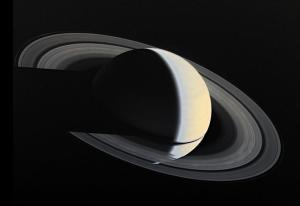
Beyond Saturn
Voyager 1 image of Saturn and its ring taken Nov. 16, 1980 four days after closest approach to Saturn, from a distance of 5,300, 000 km (3,300,000 miles). This viewing geometry, which shows Saturn as a crescent, is never achieved from Earth. The Saturnian rings, like the cloud tops of Saturn itself, are visible because they reflect sunlight. The translucent nature of the rings is apparent where Saturn can be seen through parts of the rings. Other parts of the rings are so dense with orbiting ice particles that almost no sunlight shines through them and a shadow is cast onto the yellowish cloud tops of Saturn, which in turn, casts a shadow across the rings at right. The black strip within the rings is the Cassini Division, which contains much less orbiting ring material than elsewhere in the rings.
- X





























